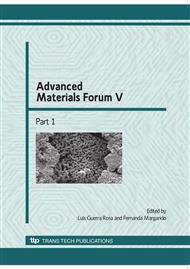p.1371
p.1377
p.1383
p.1389
p.1397
p.1404
p.1410
p.1415
p.1421
Incorporation of Coating Plaster Residues in the Formulation of Red Ceramic Mass
Abstract:
Coating plaster residues (CPR) used in the civil construction industry account for a considerable percentage of building debris. The debris generated at construction sites represents 40% of domestic waste in Brazilian municipalities, causing serious environmental problems, given that a large portion of the residue is discarded in inappropriate places. The incorporation of CPR into the mass formulations of red ceramic may be economically and environmentally beneficial. In the present study 5%, 10% and 15% of CPR was added to formulation D, with a 1:1 composition by weight of different medium plastic clays, a composite that showed the best physical and mechanical properties in a study conducted with three formulations of a ceramic industry containing compositions of 1:1, 1:2 and 2:1. The test specimens were compressed uniaxially, oven-dried (110 °C) and sintered at 850 °C, 950 °C and 1050 °C, with constant temperature for two hours. Lineal shrinkage, water absorption, apparent density, bending stress failure and section of fracture micrographs of the sample, with EDS microanalysis, were analyzed.
Info:
Periodical:
Pages:
1397-1403
Citation:
Online since:
January 2010
Price:
Сopyright:
© 2010 Trans Tech Publications Ltd. All Rights Reserved
Share:
Citation:


